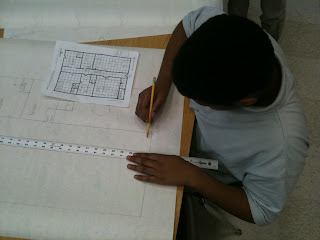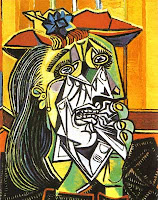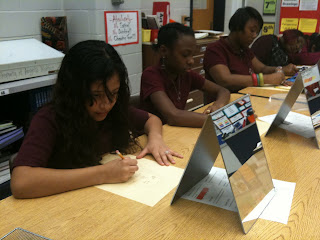In an effort to motivate middle school students to get excited about studying poetry, I collaborated with the Language Arts teacher to develop a poetry unit which incorporated art making and digital storytelling. Here is a short digital story about this very successful integration of art and technology across the curriculum.
Art Careers Projects
I love our last unit of the semester -- Art Careers. I enjoy sharing with students the vast variety of careers related to the visual arts. My Art 6 students studied the field of architecture. Working independently and in small groups they planned and drew blue prints of their dream house. I tried to incorporate Math skills by teaching them how to find the area and perimeter of their drawings.

I like to give my Art 7 and Art 8 students a choice of art careers to choose from for their independent and small group projects. The drawing on the left is a design by student who is working on a project about Industrial Design. He invented a personal handheld computer device that can fold into a cube or unfold flat. That's creativity at work.
Mrs. Mathis & the Mona Lisa

 I couldn't wait to share these photos with my students. Here I am standing in front of the Mona Lisa by Leonardo DaVinci at the Louvre in Paris, France. I first saw this painting many years ago as a backpacking college student traveling through Europe for the summer. I recently returned to the city of lights to celebrate my 20th wedding anniversary during the school break and took in all the art the city had to offer. I love this Sonia DeLaunay painting at the Pompidou Centre. This would be a great artwork for integrating math and geometry, especially circles, radius, diameter and circumference.
I couldn't wait to share these photos with my students. Here I am standing in front of the Mona Lisa by Leonardo DaVinci at the Louvre in Paris, France. I first saw this painting many years ago as a backpacking college student traveling through Europe for the summer. I recently returned to the city of lights to celebrate my 20th wedding anniversary during the school break and took in all the art the city had to offer. I love this Sonia DeLaunay painting at the Pompidou Centre. This would be a great artwork for integrating math and geometry, especially circles, radius, diameter and circumference.
Winter Themed Relief Prints - Art 8



I love printmaking with the students. This semester Art 8 students created winter theme inspired relief prints using "Easy-Cut" printing plates. Students planned their prints by sketching their designs in pencil on paper. Then, they transferred the designs to the printing plates and used black sharpies to indicate the ares that were intended to remain black. Next, they carved their printing plates using carving tools. And, finally they hand printed their plates on different colored papers. the results were great and made for a nice art display during December and January.
Surreal Inspired Dream Paintings - Art 7

 Art 7 students studied the artwork of Surrealist painter, Salvador Dali, before creating their own paintings based upon their dreams. Students also used a side profile silhouette as a unifying theme.
Art 7 students studied the artwork of Surrealist painter, Salvador Dali, before creating their own paintings based upon their dreams. Students also used a side profile silhouette as a unifying theme.
Japanese Koi Fish Watercolor Paintings


Art 8 students began a unit on watercolor painting. After practicing basic watercolor techniques, we researched images of Japanese Koi fish to paint. The finished painting were hung next to the school's large new aquarium which had been recently installed in the school lobby.
Creative Color Wheels

Students in Art 6 worked in small groups to mix paint colors for a 12 section color wheel. First, they had to mix each color on a 4x6" index card. Once dry, they had to cut a shape out of each index card. These 12 painted shapes would be used to glue down to create their painted paper color wheels.
Abstract Picasso Inspired Portraits


After completing several classes working on their self-portrait pencil drawings, I wanted to give my 7th grade art students a little more freedom to express their creativity. We read an article about Cubism and the abstract portraits of Pablo Picasso. Then, they viewed and interpreted two of his most famous works, "Weeping Woman" and "The Kiss." They wrote down their thoughts on "Post-it" notes before sharing them with the class.
Students were then given the creative challenge to draw an abstract portrait in the style of Picasso using black paper and oil pastels. I gave them just a few instructions on including a profile within the frontal view and to try to break the face up into geometric Cubism-style shapes. The rest was up to them. It was interesting to see that some students had difficulty deciding what and where to position the facial features after so many days learning how to accurately draw their self portraits. After the first class, however, they really began to show their talent as modern masters of portraiture.
Painting Value Scales

My 6 grade art students are practicing color mixing and painting value scales. First, they learned how to mix tints and shades and then they tried mixing secondary and tertiary colors using tempera paint. I think they were amazed by the variety of tints and shades that could be created by adding white or black to a color. Most students enjoyed the challenge of mixing just the right color and trying not to contaminate their primary colors.
Self-Portrait Student Critique
 At the end of our lesson on drawing the face, Art 7 students had a peer-to-peer critique of their self portraits. Students volunteered to critique a drawing which they thought was successful. I like to use the PQP critique process which means make a POSITIVE comment about the artwork; Ask a QUESTION of the artist about the artwork; and tell what you think the artist could have done to POLISH or improve upon the artwork even more.
At the end of our lesson on drawing the face, Art 7 students had a peer-to-peer critique of their self portraits. Students volunteered to critique a drawing which they thought was successful. I like to use the PQP critique process which means make a POSITIVE comment about the artwork; Ask a QUESTION of the artist about the artwork; and tell what you think the artist could have done to POLISH or improve upon the artwork even more.
Drawing Self-Portraits - Art 7
 This week students learned about theabout the shape, position and proportion of facial features. They practiced drawing their self-portraits to demonstrate their understanding of the approximate symmetry of the face and correct positioning and proportion of the eyes, nose, mouth and ears.
This week students learned about theabout the shape, position and proportion of facial features. They practiced drawing their self-portraits to demonstrate their understanding of the approximate symmetry of the face and correct positioning and proportion of the eyes, nose, mouth and ears.The students were excited to use the mirrors to draw their portraits. Some were even a little obsessed with looking at themselves, others seems a little uncomfortable about focusing so intently on every detail of their facial features. In the end, after about 3 classes of practice, their "After" portraits were so much more improved from their pre-instruction "Before" portraits.


Egyptian Tomb Drawings - Art 8
 For several classes 8th grade art students have been studying the Art of Ancient Egypt. For their art project, they had to brainstorm an idea for drawing in the style of an Egyptian Tomb Painting. The artwork had to include a Hieroglyphic message and symbols with Egyptian figures.
For several classes 8th grade art students have been studying the Art of Ancient Egypt. For their art project, they had to brainstorm an idea for drawing in the style of an Egyptian Tomb Painting. The artwork had to include a Hieroglyphic message and symbols with Egyptian figures.The finished drawings were very creative. The messages ranged from sports to friendship and love.
Finish the Animal Drawings - Art 6
Students created animal drawings from photographic sources to demonstrate their understanding of color, value and texture using colored pencil techniques.

They searched through old National Geographic magazines and old nature calendars for images of animals. Then they cut the image in half and drew and colored the missing half with colored pencils.
Shoe Contour Drawings - Art 7
 Students practiced contour drawings of simple objects before attempting to draw their shoes. First they drew in pencil, then went over their drawings in ink. As a part of our unit on color, they used different color schemes to add emphasis to their shoes. They also had to design a black and white pattern for their background.
Students practiced contour drawings of simple objects before attempting to draw their shoes. First they drew in pencil, then went over their drawings in ink. As a part of our unit on color, they used different color schemes to add emphasis to their shoes. They also had to design a black and white pattern for their background.
2-Pt Perspective Cityscape Drawings - Art 8
 Students studied linear perspective and practiced drawing in both 1-pt and 2-pt perspective using rulers and triangles. Then students drew an imaginary city in 2-pt perspective.
Students studied linear perspective and practiced drawing in both 1-pt and 2-pt perspective using rulers and triangles. Then students drew an imaginary city in 2-pt perspective.
Color Wheel Worksheet - Art 6
 As an introduction to learning about color mixing, Art 6 students practiced completing a 12 section color wheel using colored pencils and crayons. Later they will create a larger more creative color wheel using tempera paints.
As an introduction to learning about color mixing, Art 6 students practiced completing a 12 section color wheel using colored pencils and crayons. Later they will create a larger more creative color wheel using tempera paints.
Kaleidoscope Name Design - Art 7
Students created a kaleidoscope design of their name to demonstrate understanding of radial balance.


Stacked Contour Drawings - Art 6
 Sixth grade art students created contour line drawings of simple objects, like fruit, small toys, musical instruments and kitchen utensils to demonstrate their understanding of seeing the detailed contours of an object when drawing.
Sixth grade art students created contour line drawings of simple objects, like fruit, small toys, musical instruments and kitchen utensils to demonstrate their understanding of seeing the detailed contours of an object when drawing.Artists you Should Know
 Here's a bulletin board in the art room of famous artworks by famous artists students should know. Can you name any of these artists?
Here's a bulletin board in the art room of famous artworks by famous artists students should know. Can you name any of these artists?
Negative Space Name Design - Art 6
 Students created an abstract design of their names using the negative spaces within each letter to demonstrate their understanding of positive and negative space.
Students created an abstract design of their names using the negative spaces within each letter to demonstrate their understanding of positive and negative space.
Elements of Art Drawings - Art 8
 Students created drawings to demonstrate their understanding of the 7 elements of Art: Line, Shape, Space, Form, Color, Value and Texture.
Students created drawings to demonstrate their understanding of the 7 elements of Art: Line, Shape, Space, Form, Color, Value and Texture.Students divided their paper into sections and created small drawings of each element.
Line Types Art Project - Art 6
 Students created a mixed media drawing to demonstrate their understanding of the 5 major types of lines used in Art: Vertical, Horizontal, Diagonal, Curved and Zigzag.
Students created a mixed media drawing to demonstrate their understanding of the 5 major types of lines used in Art: Vertical, Horizontal, Diagonal, Curved and Zigzag.Students divided their paper into sections for each type of line. Then they used crayons to draw the different line types. Next, they painted each section with watercolors. some students used oil pastels to emphasize some of the lines.
Elements of Art Drawings - Art 7
 Students created a drawing to demonstrate their understanding of the "Elements of Art": Line, Shape, Space, Form, Color, Value and Texture. Using a series of difference types of lines as an element of emphasis, students divided the paper into different sections for each element.
Students created a drawing to demonstrate their understanding of the "Elements of Art": Line, Shape, Space, Form, Color, Value and Texture. Using a series of difference types of lines as an element of emphasis, students divided the paper into different sections for each element.
Subscribe to:
Posts (Atom)










